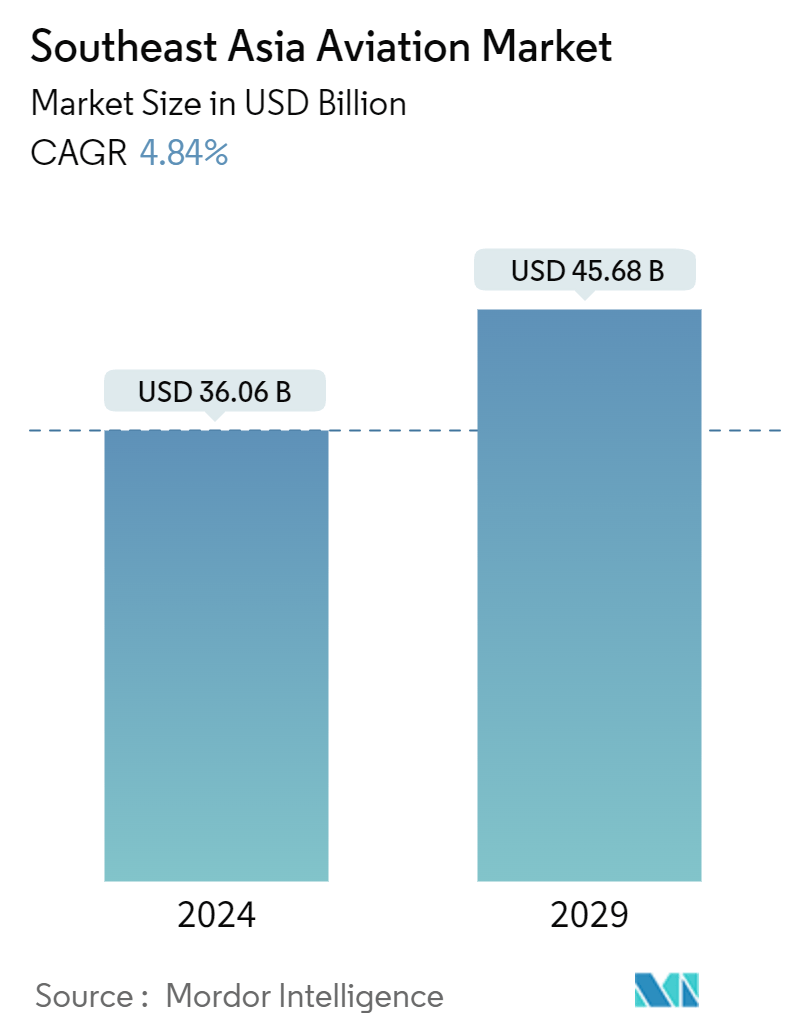Market Size of Southeast Asia Aviation Industry

| Study Period | 2019 - 2029 |
| Base Year For Estimation | 2023 |
| Market Size (2024) | USD 36.06 Billion |
| Market Size (2029) | USD 45.68 Billion |
| CAGR (2024 - 2029) | 4.84 % |
| Market Concentration | Low |
Major Players
*Disclaimer: Major Players sorted in no particular order |
Southeast Asia Aviation Market Analysis
The Southeast Asia Aviation Market size is estimated at USD 36.06 billion in 2024, and is expected to reach USD 45.68 billion by 2029, growing at a CAGR of 4.84% during the forecast period (2024-2029).
The expanding middle-income demographic in Southeast Asia and the surge in economic advancements have led to a rise in the accessibility and need for air transportation. This region has become a favored tourist hotspot, drawing in millions annually. The upsurge in tourism has contributed to the escalation of air traveler numbers in the area.
The aviation market in Southeast Asia is characterized by intense competition, wherein full-service and low-cost carriers vie for a portion of the market. This competitive environment places significant financial strain on airlines, necessitating stringent adherence to safety protocols amidst challenges such as airspace coordination and governmental regulations.
Focus on indigenous manufacturing by various countries in the region is also likely to boost the armed forces' procurement of various advanced aircraft and rotorcraft, which is expected to be one of the market growth drivers during the forecast period.
Southeast Asia Aviation Industry Segmentation
The report considers revenues from new aircraft deliveries and affiliate service contracts. Similarly, the report analyses investments in new airports, aircraft procurement programs, defense spending, and various business expansions by multiple companies.
The Southeast Asian aviation market is segmented by type and geography. By type, the market is segmented into commercial, military, and general aviation. The report also offers the market size and forecasts for five countries across the region. The market sizing and forecasts have been provided in value (USD).
| Type | |||||
| |||||
| |||||
|
| Country | |
| Singapore | |
| Indonesia | |
| Thailand | |
| Philippines | |
| Malaysia | |
| Rest of Southeast Asia |
Southeast Asia Aviation Market Size Summary
The Southeast Asia aviation market is poised for significant growth, driven by an expanding middle-income demographic and increased economic activity, which have heightened the demand for air travel. The region's appeal as a tourist destination has further fueled the rise in air passenger numbers. The market is characterized by intense competition among full-service and low-cost carriers, which, while fostering innovation and service improvements, also impose financial pressures on airlines. The focus on indigenous manufacturing and military procurement of advanced aircraft is expected to contribute to market expansion. The commercial aviation sector, in particular, is anticipated to experience robust growth due to fleet modernization efforts and increased market penetration by airlines, supported by rising disposable incomes and a thriving tourism industry in countries like Indonesia, Thailand, the Philippines, and Singapore.
Singapore stands out as a major aviation hub, with its Changi Airport being one of the busiest globally, and Singapore Airlines leading in regional operations. The country's strategic investments in defense and military capabilities, alongside its proximity to key regional players, underscore its commitment to maintaining a strong presence in both commercial and military aviation sectors. The fragmented nature of the Southeast Asian aviation market presents substantial opportunities for growth, with foreign players like Boeing, Airbus, and Lockheed Martin playing pivotal roles. These companies are not only dominating the market but are also establishing manufacturing facilities in the region, enhancing collaboration with local aerospace firms. This dynamic landscape is expected to drive further investments and expansions, positioning Southeast Asia as a critical player in the global aviation industry.
Southeast Asia Aviation Market Size - Table of Contents
-
1. MARKET DYNAMICS
-
1.1 Market Overview
-
1.2 Market Drivers
-
1.3 Market Restraints
-
1.4 Porter's Five Forces Analysis
-
1.4.1 Threat of New Entrants
-
1.4.2 Bargaining Power of Buyers/Consumers
-
1.4.3 Bargaining Power of Suppliers
-
1.4.4 Threat of Substitute Products
-
1.4.5 Intensity of Competitive Rivalry
-
-
-
2. MARKET SEGMENTATION
-
2.1 Type
-
2.1.1 Commercial Aircraft
-
2.1.1.1 Passenger Aircraft
-
2.1.1.2 Freighter Aircraft
-
-
2.1.2 Military Aircraft
-
2.1.2.1 Combat Aircraft
-
2.1.2.2 Non-combat Aircraft
-
-
2.1.3 General Aviation
-
2.1.3.1 Helicopter
-
2.1.3.2 Turboprop Aircraft
-
2.1.3.3 Business Jets
-
-
-
2.2 Country
-
2.2.1 Singapore
-
2.2.2 Indonesia
-
2.2.3 Thailand
-
2.2.4 Philippines
-
2.2.5 Malaysia
-
2.2.6 Rest of Southeast Asia
-
-
Southeast Asia Aviation Market Size FAQs
How big is the Southeast Asia Aviation Market?
The Southeast Asia Aviation Market size is expected to reach USD 36.06 billion in 2024 and grow at a CAGR of 4.84% to reach USD 45.68 billion by 2029.
What is the current Southeast Asia Aviation Market size?
In 2024, the Southeast Asia Aviation Market size is expected to reach USD 36.06 billion.

